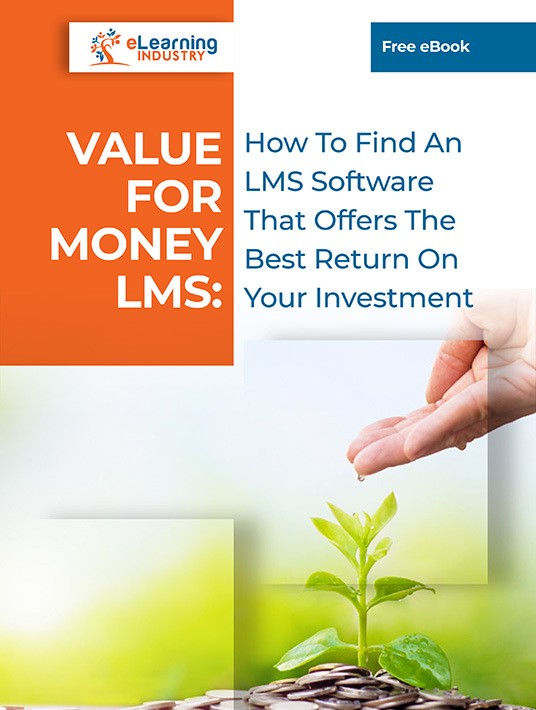9 Terms Every LMS Buyer Needs To Know To Find A Value For Money LMS
All investment requires a solid business case. With Learning Management Systems, it can be difficult to describe the benefits to non-L&D colleagues. You’ll need to have solid responses to the same old questions. Why is it so important to invest in online training? What’s wrong with the system we have now? Why would your corporate learners want to change from a classroom environment to an online one? You’re fully aware of the impact a global, consolidated online training course would have on corporate learners. Employing some important vocabulary when you’re talking about a value for money LMS is going to be essential. Here are the 9 terms you need to know.

1. Return On Investment (ROI)
What’s your goal for implementing a new LMS? What’s your online training strategy and how does an LMS contribute to achieving your L&D objectives? In general terms, ROI is usually a calculation of the impact of skills training:
Highly skilled workforce + improved processes = better customer experience, higher staff retention
Experienced staff + happy customers = positive impact on the bottom line
Be ready to describe your ROI in simple terms, from the outset of your eLearning project. Ensure the LMS you are purchasing will provide these positive impacts. You can then feel assured in communicating with senior leaders that LMS benefits are real and tangible.
2. Value For Money LMS And Its Effectiveness
Does the system meet your learning objectives? The value of an LMS investment comes in large part from time-saving. Online training reduces travel time, minimizing disruption to the individual. An LMS provides global teams with faster and stronger collaboration through online training and communities. The vastly improved analytics capability enables faster and more consistent management reporting. Discussing how the LMS meets those learning objectives allows you to assess the value for money in a measurable way.
3. Request For Proposal (RFP) When Choosing A Value For Money LMS
Many organizations choose to send a formal Request For Proposal to LMS vendors before making their final decision. This proposal gives them all the information they need to prepare a bid, from the scope of their corporate eLearning project and learning objectives to the estimated budget. An RFP can help you vet LMS vendors more effectively and ensure that you get the best value for money LMS, as vendors are able to custom tailor their LMS package to meet your specific requirements.
4. Platform Efficiency
Does the LMS improve productivity? Consider the long-term value you are gaining from the investment. Describe efficiency in terms of the benefits the LMS will bring: reduced turnover, long-term engagement, and specialized in-house training capabilities. Use this term to talk about the real impact of the LMS on corporate success. Focus on these benefits in discussions with LMS vendors – the best ones will know how to support your efficiency goals.
5. Economy Of A Value For Money LMS
How does the LMS cut costs? Depending on the type of system you’re researching, there could be a whole number of positive cost implications. If you’re moving to a cloud-based LMS, you’ll have reduced infrastructure costs. If you’re moving from a classroom model of training delivery to online training, you’ll avoid all the travel and facilities expenses. Whether you’re in a highly regulated industry, you’ll avoid high penalties for failure to complete essential compliance training. Considering the ways in which investing in an LMS will cut costs is a vital element in finding a value for money LMS.
6. User Experience
What impact does the system have on the overall satisfaction of employees? Think about how moving to a consolidated environment with thoroughly redesigned online training materials will improve the experience of online training. Is this a responsive LMS, meaning the interface will operate smoothly and consistently across devices? That will enable corporate learners to train whenever and wherever they choose. Timely training will improve brand knowledge and connection, particularly for field staff. For all employees, demonstrating a commitment to skills development will have a positive impact on employee engagement.
7. Value Proposition
LMS vendors use value propositions to demonstrate how their product can benefit your organization and its bottom line. This may include a detailed explanation of the Unique Selling Points (USPs). However, you must do your homework to determine which is the best value for money LMS. Online reviews, free trials, and LMS vendor meetings can help you calculate the true value of the LMS platform.
8. Pricing Model
Different platforms offer different pricing options, from one-time licensing fees to monthly subscriptions. As such, organizations must weight all the options to determine which is best for their organization’s needs and budget. There also free solutions, such as open source software, that typically require more IT know-how. Pricing models also involve different deployment options, including cloud-based (SaaS), locally hosted, and mobile apps. eLearning Industry’s online directory allows you to narrow your search results by pricing and deployment type to find the ideal platform with ease.
9. Perceived Usefulness
In terms of Learning Management Systems, the perceived usefulness is the extent to which your employees feel the platform will enhance their performance. This applies to both your L&D staff and corporate learners, having also a direct impact on the LMS’s value for money. A usable LMS improves functionality and productivity, translating into higher online training ROI.
Choosing a new LMS is much more than upgrading a system. It’s about obtaining the goals you’ve set, and you must be able to bring stakeholders on the journey. Especially those who don’t recognize the value of your L&D strategy. How do you describe the value for money of an LMS? How do you calculate the value of a potential investment to be sure you’re making the right recommendation? Choosing these 9 terms upon which to focus your research will determine which value for money LMS is right for you. Any system that can’t provide you with the benefits in these areas is not going to build that all-important business case.
Our free eBook Value For Money Learning Management Systems can help you find an LMS that delivers the best value for money. It features the top LMS features to look for, as well as tips to choose the ideal pricing model for your organization.

